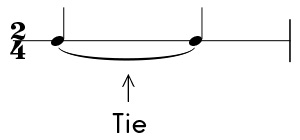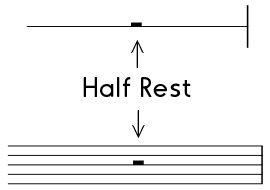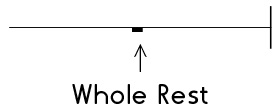Home - Fundamentals of Rhythm Table of Contents
Lesson 2: Ties, Half Notes, Dotted Half Notes, Whole Notes, and Rests
Lesson 1 introduced notes and rests that are equal to one beat: quarter notes and quarter rests in 2/4, 3/4, and 4/4 time. In this lesson we will learn notes and rests that are longer than one beat.
The Tie
One way to create longer notes is with the tie. A tie is a line that connects two or more notes that are the same pitch. The tie indicates that we hold the notes together without re-articulating or restarting the second note of the tie.

There are simpler ways to represent most tied notes, though. Here is a list of note values and how long they are in relation to quarter notes.
The Half Note
The half note is equal to the length of two quarter notes tied together. Therefore, when the quarter note is equal to one beat, the half note is equal to two beats.

The Dotted Half Note
When a dot is added to the right side of a note, it means that half of that note value is added to its length. In the case of the dotted half note, a half note is tied to a quarter note. Another way to count the dotted half note is to think of it as being equal to the length of three quarter notes tied together. Therefore, when the quarter note is equal to one beat, the half note is equal to three beats. Dotted half notes will never occur in 2/4 time because they have too many beats for a measure.

The Whole Note
The whole note is equal to the length of four quarter notes tied together. Therefore, when the quarter note is equal to one beat, the whole note is equal to four beats. Whole notes will never occur in 2/4 or 3/4 time because they have too many beats for a measure in those time signatures. Visually, the whole note is unique in that it does not have a stem. The whole note consists of just a notehead.

The Half Rest
Just as a half note is equal to two quarter notes, a half rest is equal to two quarter rests. On a one-line staff, the half rest sits on top of the line. In a traditional five-line staff, the half rest sits on top of the middle line.

Some of the rhythm patterns in Lesson 1 of The Fundamentals of Rhythm include rests that last for a few beats. However, two quarter rests are more easily notated with a half rest. The dotted half rest is not very common. Three quarter rests will usually be represented by a half rest and a quarter rest instead.
The Whole Rest
The whole rest looks very similar to a half rest, but it sits just beneath a staff line.

The whole rest is a unique symbol in music notation. Its length is determined by the time signature in which it occurs. It indicates that the entire measure should be silent. Therefore, in 2/4 time the whole rest is equal to two beats:

In 3/4 time the whole rest is equal to three beats:

In 4/4 time the whole rest is equal to four beats:

Learn ties over measure lines and syncopations in Lesson 3.
Write your own rhythms and music compositions! Get free blank staff paper at www.music-paper.com.







Get the Book
Fundamentals of Rhythm book
If you would like all of this information in book format so that you can put it on your music stand and practice it wherever you go, get The Fundamentals of Rhythm, by Kyle Coughlin. The book includes all of the lesson information and practice exercises found on the website.
Use MetronomeBot for a fun online metronome!
The online metronome that counts the beat, subdivides, and offers encouraging practice tips.
If you like this site, please share it with others!


Like Kyle Coughlin Music on Facebook
Follow Kyle Coughlin Music on Twitter